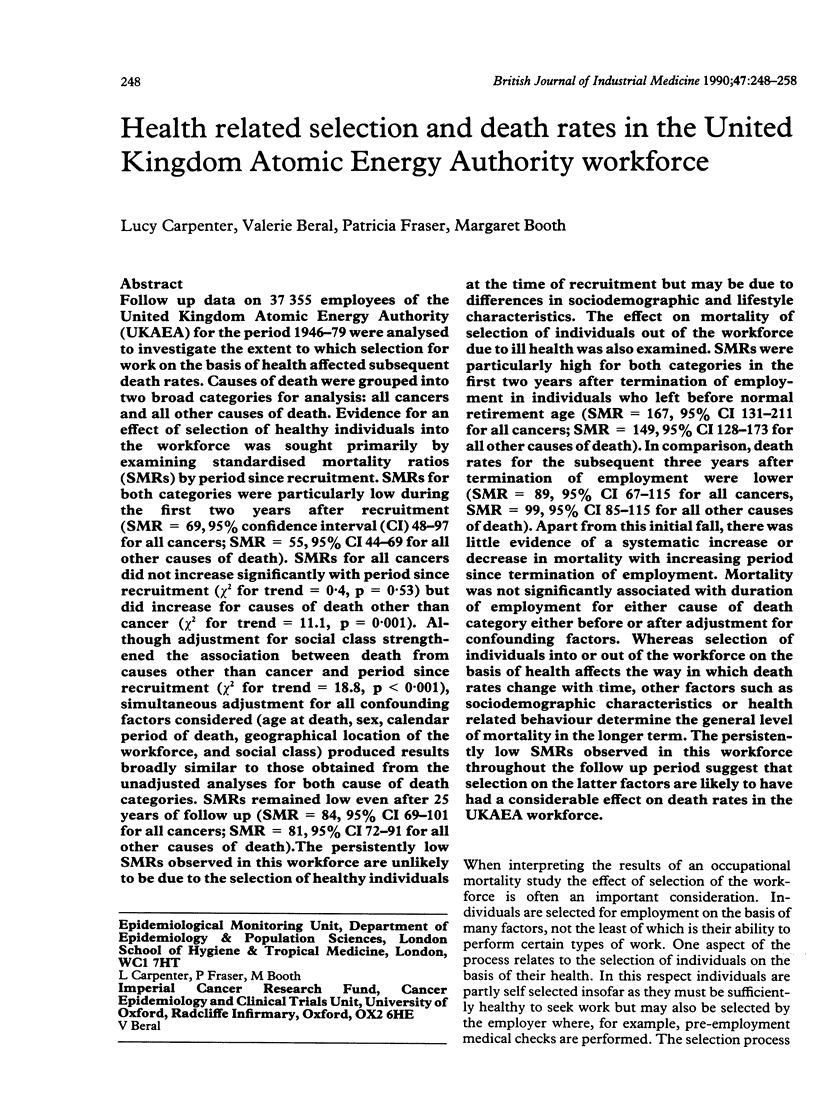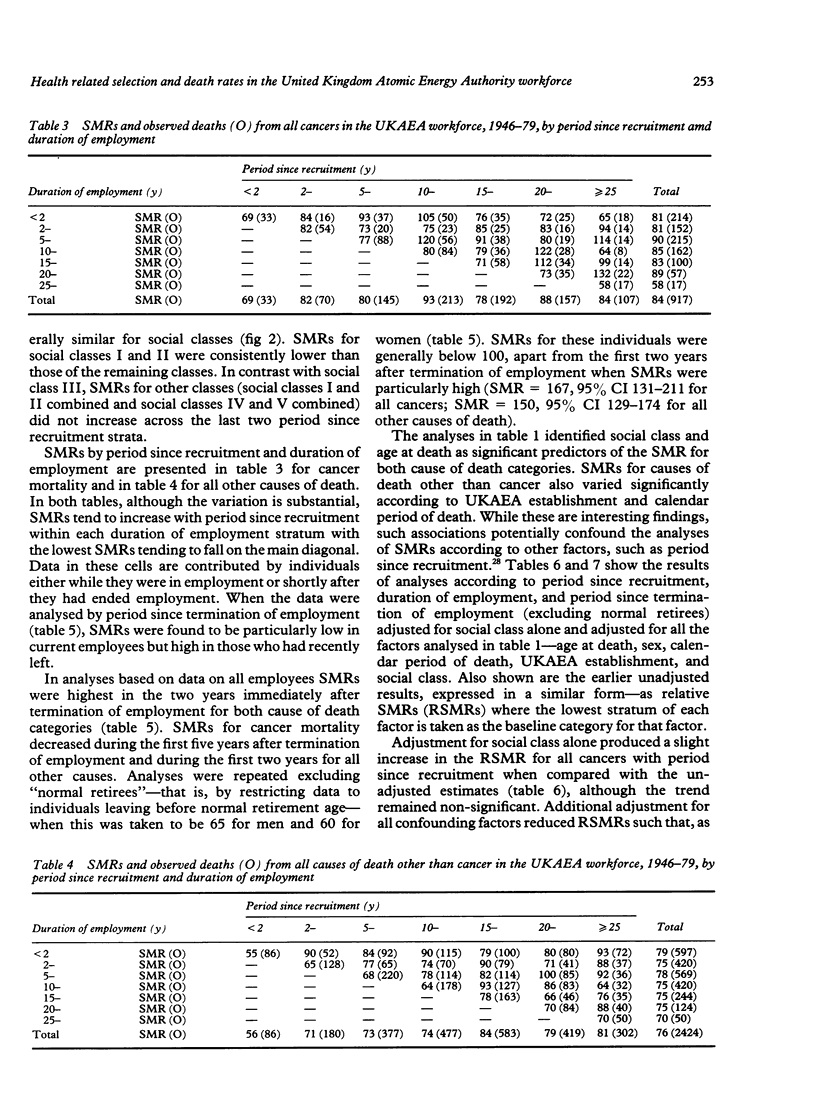Abstract
Follow up data on 37,355 employees of the United Kingdom Atomic Energy Authority (UKAEA) for the period 1946-79 were analysed to investigate the extent to which selection for work on the basis of health affected subsequent death rates. Causes of death were grouped into two broad categories for analysis: all cancers and all other causes of death. Evidence for an effect of selection of healthy individuals into the workforce was sought primarily by examining standardised mortality ratios (SMRs) by period since recruitment. SMRs for both categories were particularly low during the first two years after recruitment (SMR = 69, 95% confidence interval (CI) 48-97 for all cancers; SMR = 55, 95% CI 44-69 for all other causes of death). SMRs for all cancers did not increase significantly with period since recruitment (chi 2 for trend = 0.4, p = 0.53) but did increase for causes of death other than cancer (chi 2 for trend = 11.1, p = 0.001). Although adjustment for social class strengthened the association between death from causes other than cancer and period since recruitment (chi 2 for trend = 18.8, p less than 0.001), simultaneous adjustment for all confounding factors considered (age at death, sex, calendar period of death, geographical location of the workforce, and social class) produced results broadly similar to those obtained from the unadjusted analyses for both cause of death categories. SMRs remained low even after 25 years of follow up (SMR = 84, 95% CI 69-101 for all cancers; SMR = 81, 95% CI 72-91 for all other causes of death). The persistently low SMRs observed in this workforce are unlikely to be due to the selection of healthy individuals at the time of recruitment but may be due to differences in sociodemographic and lifestyle characteristics. The effect on mortality of selection of individuals out of the workforce due to ill health was also examined. SMRs were particularly high for both categories in the first two years after termination of employment in individuals who left before normal retirement age (SMR = 167, 95% CI 131-211 for all cancers; SMR = 149, 95% CI 128-173 for all other causes of death). In comparison, death rates for the subsequent three years after termination of employment were lower (SMR = 89, 95% CI 67-115 for all cancers, SMR = 99, 95% CI 85-115 for all other causes of death). The persistently low SMRs observed in this workforce are unlikely to be due to the selection of healthy individuals at the time of recruitment but may be due to differences in sociodemographic and lifestyle characteristics. The effect on mortality of selection of individuals out of the workforce due to ill health was also examined. SMRs were particularly high for both categories in the first two years after termination of employment in individuals who left before normal retirement age (SMR = 167, 95% CI 131-211 for all cancers; SMR 149,95% CI 128-173 for all other causes of death). In comparison, death rates for the subsequent three years after termination of employment were lower (SMR = 89, 95% CI 67-115 for all cancers SMR = 99, 95% CI 85-115 for all other causes of death). Apart from this initial fall, there was little evidence of a systematic increase or decrease in mortality with increasing period was not significantly associated with durationof employment for either cause of death category either before or after adjustment for confounding factors. Whereas selection of individuals into or out of the workforce on the basis of health affects the way in which death rates change with time, other factors such as sociodemographic characteristics or health related behaviour determine the general level of mortality in the longer run. The persistently low SMRs observed in this workforce throughout the follow up period suggest that selection on the latter factors are likely to have had a considerable effect on death rates in the UKAEA workforce.
Full text
PDF










Selected References
These references are in PubMed. This may not be the complete list of references from this article.
- Bell C. M., Coleman D. A. Models of the healthy worker effect in industrial cohorts. Stat Med. 1987 Dec;6(8):901–909. doi: 10.1002/sim.4780060805. [DOI] [PubMed] [Google Scholar]
- Beral V., Inskip H., Fraser P., Booth M., Coleman D., Rose G. Mortality of employees of the United Kingdom Atomic Energy Authority, 1946-1979. Br Med J (Clin Res Ed) 1985 Aug 17;291(6493):440–447. doi: 10.1136/bmj.291.6493.440. [DOI] [PMC free article] [PubMed] [Google Scholar]
- Berry G. The analysis of mortality by the subject-years method. Biometrics. 1983 Mar;39(1):173–184. [PubMed] [Google Scholar]
- Fox A. J., Collier P. F. Low mortality rates in industrial cohort studies due to selection for work and survival in the industry. Br J Prev Soc Med. 1976 Dec;30(4):225–230. doi: 10.1136/jech.30.4.225. [DOI] [PMC free article] [PubMed] [Google Scholar]
- Fox A. J., Goldblatt P. O., Adelstein A. M. Selection and mortality differentials. J Epidemiol Community Health. 1982 Jun;36(2):69–79. doi: 10.1136/jech.36.2.69. [DOI] [PMC free article] [PubMed] [Google Scholar]
- Gilbert E. S. Some confounding factors in the study of mortality and occupational exposures. Am J Epidemiol. 1982 Jul;116(1):177–188. doi: 10.1093/oxfordjournals.aje.a113392. [DOI] [PubMed] [Google Scholar]
- Hernberg S. "Negative" results in cohort studies--how to recognize fallacies. Scand J Work Environ Health. 1981;7 (Suppl 4):121–126. [PubMed] [Google Scholar]
- Howe G. R., Chiarelli A. M., Lindsay J. P. Components and modifiers of the healthy worker effect: evidence from three occupational cohorts and implications for industrial compensation. Am J Epidemiol. 1988 Dec;128(6):1364–1375. doi: 10.1093/oxfordjournals.aje.a115089. [DOI] [PubMed] [Google Scholar]
- Inskip H., Beral V., Fraser P., Booth M., Coleman D., Brown A. Further assessment of the effects of occupational radiation exposure in the United Kingdom Atomic Energy Authority mortality study. Br J Ind Med. 1987 Mar;44(3):149–160. doi: 10.1136/oem.44.3.149. [DOI] [PMC free article] [PubMed] [Google Scholar]
- McDonald A. D., Fry J. S., Woolley A. J., McDonald J. C. Dust exposure and mortality in an American chrysotile asbestos friction products plant. Br J Ind Med. 1984 May;41(2):151–157. doi: 10.1136/oem.41.2.151. [DOI] [PMC free article] [PubMed] [Google Scholar]
- McMichael A. J. Standardized mortality ratios and the "healthy worker effect": Scratching beneath the surface. J Occup Med. 1976 Mar;18(3):165–168. doi: 10.1097/00043764-197603000-00009. [DOI] [PubMed] [Google Scholar]
- Monson R. R. Observations on the healthy worker effect. J Occup Med. 1986 Jun;28(6):425–433. doi: 10.1097/00043764-198606000-00009. [DOI] [PubMed] [Google Scholar]
- Pearce N., Checkoway H., Shy C. Time-related factors as potential confounders and effect modifiers in studies based on an occupational cohort. Scand J Work Environ Health. 1986 Apr;12(2):97–107. doi: 10.5271/sjweh.2161. [DOI] [PubMed] [Google Scholar]
- Seltzer C. C., Jablon S. Effects of selection on mortality. Am J Epidemiol. 1974 Nov;100(5):367–372. doi: 10.1093/oxfordjournals.aje.a112047. [DOI] [PubMed] [Google Scholar]
- Vinyl chloride and mortality? Lancet. 1976 Aug 21;2(7982):416–417. [PubMed] [Google Scholar]
- Wang J. D., Miettinen O. S. Occupational mortality studies. Principles of validity. Scand J Work Environ Health. 1982 Sep;8(3):153–158. doi: 10.5271/sjweh.2480. [DOI] [PubMed] [Google Scholar]
- Weed D. L. An epidemiological application of Popper's method. J Epidemiol Community Health. 1985 Dec;39(4):277–285. doi: 10.1136/jech.39.4.277. [DOI] [PMC free article] [PubMed] [Google Scholar]
- Weed D. L., Tyroler H. A., Shy C. The healthy worker effect in actively working communications workers. J Occup Med. 1987 Apr;29(4):335–339. [PubMed] [Google Scholar]
- Wilcosky T., Wing S. The healthy worker effect. Selection of workers and work forces. Scand J Work Environ Health. 1987 Feb;13(1):70–72. doi: 10.5271/sjweh.2078. [DOI] [PubMed] [Google Scholar]


